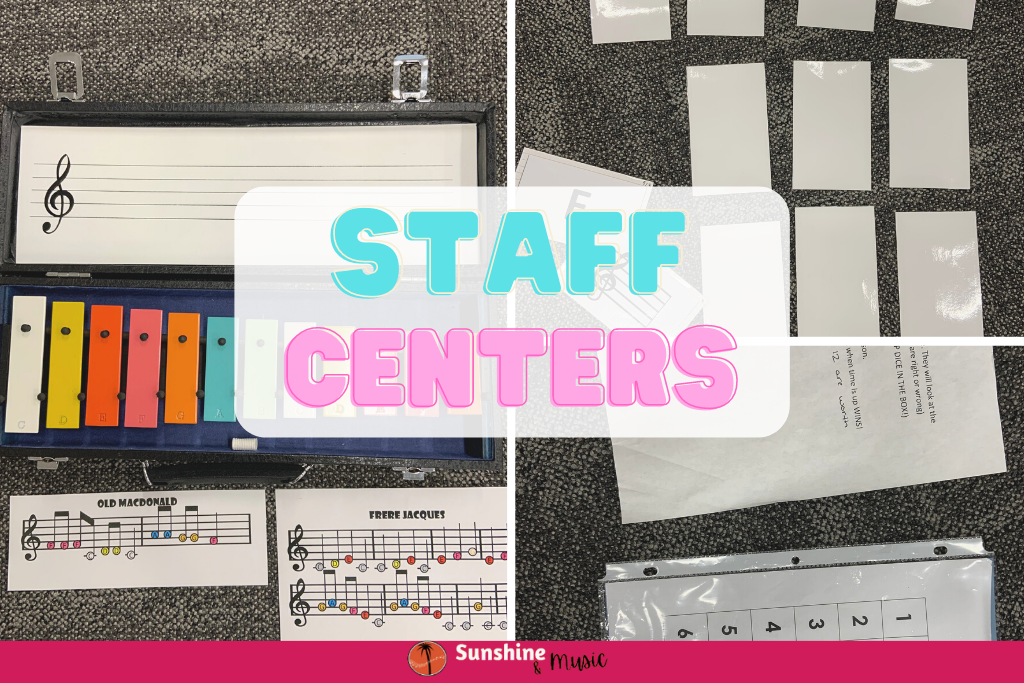Music centers are a great way to give your students hands-on experience with a variety of musical concepts. Not only do they allow for a more interactive and engaging learning experience, but they also give students the opportunity to explore and discover on their own.
Here are a few tips and tricks to help you make the most of music centers in your elementary music classroom Plus some examples of how I have used centers in my own music classroom.

Using Music Centers in the Elementary Classroom
- Organize your centers carefully. Make sure that each center has a clear purpose and that the materials at each center are well-organized and easy to use. Be sure to label each center and the materials within it so that students know what to expect and where to find what they need.
- Provide clear instructions and expectations. Before allowing students to use the centers, make sure that they understand how each center works and what is expected of them. Provide clear instructions for each center and make sure students know what they should be working on while they are at the center. I usually teach each center as a class before having them try it by themselves.
- Incorporate centers into your curriculum. Use the centers to reinforce concepts and skills that you are teaching in class. For example, you could use a rhythm center to reinforce rhythm reading and counting, or use ukulele centers to work on ukulele skills.
- Evaluate and adjust. Observe students as they use the centers and take note of what is working well and what needs improvement. Use this information to make adjustments and improvements to the centers as needed.
Music Centers Ideas
Ukulele Music Centers
I use Rainbow Ukulele with my students. It is a self-paced ukulele unit where students get to learn songs of increasing difficulty. During Rainbow Ukulele time, students work at centers while I call students up to play songs for me.

This year, the centers I’m using are:
- Rhythm jenga (rhythm review)
- Ukulele practice time
- Ukulele memory matching game (review strings, notes and chords)
- Music trivia
- Partner testing station: opportunity to pass a level by playing a song for your partner
Instruments of the Orchestra Music Centers
After we had learning about the instruments of the orchestra, I had students work with groups in center to practice their knowledge. Here are the centers I used.
- Instrument memory game
- Instrument go fish
- Sorting instruments by family
- Instrument Heads Up/Heandbandz

Recorder Music Centers
When I teach recorders, I have centers similar to ukulele. Students work at their station and then play songs for me when I call them up.
Some ideas for recorder stations include:
- Partner testing station
- Recorder practice station
- Recorder note memory game
- Recorder bingo
- Make your own song – mix and match song fragments to create your own song
Rhythm Centers
Rhythm centers are another fun option. Here are some ideas you might try:
- Use rhythm cards with two beat rhythms on them to create larger rhythms
- Lego rhythms – build rhythm use legos with rhythmic note values written on them
- Note tracing. Students could trace the notes on a worksheet.
- Read and play rhythms on small percussion.
Notes of the Staff Centers
I used centers with my fifth graders to help them practice learning the notes of the staff. Here are the centers we used.
- Staff candy land
- Write your own mnemonic device to help remember the notes of the staff.
- Roll a note: students roll dice and then name the note on the staff that matches that number on the included piece of paper at the station.
- Staff memory game: match the note name with the note on the staff
- Read notation to play familiar song on glockenspiels.

Composer Centers
You could even use centers to learn about famous composers! Here is a different way of doing centers to consider. You could have facts about different parts of the composer’s life at each station. Groups could rotate through and fill out facts about the composer at each center as they go.
Music centers are a great way to make learning music more interactive and engaging for your students. By following these tips and tricks, you can make sure that your music centers are well-organized, effective, and enjoyable for everyone. Happy teaching!
More Blog Posts About Centers in Music Class
Try Carpe Diem Music’s blog post all about music centers – How to Plan Elementary Music Centers for the Classroom in 9 Easy Steps








3 Responses